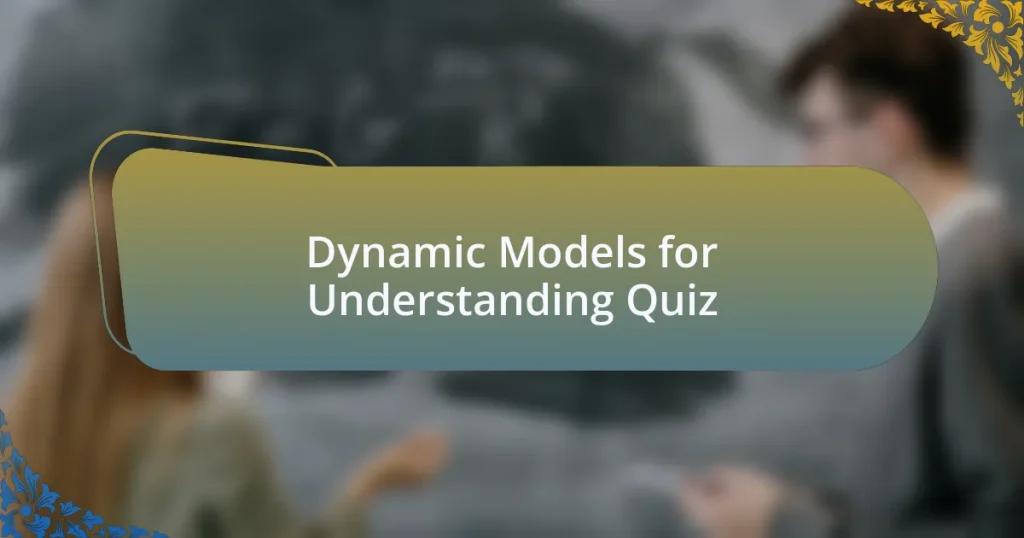Start of Dynamic Models for Understanding Quiz
1. What is the primary focus of dynamic modeling?
- Measuring static forces within a system.
- Understanding and analyzing complex systems and their dynamics over time.
- Predicting the exact outcome of a single event.
- Simplifying systems to their basic components.
2. What do stocks represent in dynamic modeling?
- Random fluctuations in the environment.
- Instantaneous changes in state.
- Accumulation of materials or information.
- Constant speed or velocity changes.
3. What do flows represent in dynamic modeling?
- Fixed quantities in a model.
- Rates of change of stocks.
- Graphs of static equilibrium.
- Initial conditions of a system.
4. What is a feedback loop in dynamic modeling?
- A cycle of cause and effect where the output of a system affects its input.
- A one-time event that does not influence future conditions.
- A static model with fixed parameters that never changes.
- An isolated phenomenon without any interactions.
5. What is non-linear dynamics in dynamic modeling?
- A system that only behaves linearly under all conditions.
- A straightforward, predictable system with fixed relationships.
- Continuous behavior with slight modifications causing no major impact.
- Behavior where small changes can lead to large and disproportionate effects.
6. What is the first step in system dynamics modeling?
- Translating diagrams into a mathematical model.
- Problem definition.
- Running simulations and analyzing results.
- Creating a stock and flow diagram.
7. What is the second step in system dynamics modeling?
- Running simulations and analyzing results.
- Creating a stock and flow diagram.
- Defining the system boundaries.
- Translating diagrams into a mathematical model.
8. What is the third step in system dynamics modeling?
- Creating a stock and flow diagram.
- Defining the system boundaries.
- Creating a causal loop diagram.
- Problem definition.
9. What is the fourth step in system dynamics modeling?
- Creating a causal loop diagram.
- Developing a mathematical model.
- Running simulations and analyzing results.
- Defining system boundaries.
10. What is the fifth step in system dynamics modeling?
- Eliminating variables to simplify the model.
- Translating diagrams into a mathematical model.
- Developing a simulation without validation.
- Creating only a qualitative description of the system.
11. What is the sixth step in system dynamics modeling?
- Collecting initial data for analysis
- Drafting the research proposal
- Running simulations and analyzing results
- Writing the final report on findings
12. What is system dynamics used for in policy analysis?
- Generating random scenarios for decision making.
- Evaluating individual performance metrics in isolation.
- Predicting market trends based on historical data.
- Analyzing the impact of different policies on a system.
13. What is system dynamics used for in business strategy?
- Implementing employee training programs.
- Conducting market surveys.
- Analyzing financial statements.
- Developing and evaluating business strategies.
14. What is system dynamics used for in environmental modeling?
- Designing engineering structures.
- Predicting stock market fluctuations.
- Modeling and analyzing environmental systems.
- Simulating random events in physics.
15. What is system dynamics used for in healthcare?
- Scheduling patient appointments.
- Creating financial reports for hospitals.
- Designing new medical devices.
- Modeling and analyzing healthcare systems.
16. What is the holistic approach of system dynamics?
- Focusing solely on the individual parts without context.
- Considering the entire system, rather than individual components.
- Ignoring interactions between system components entirely.
- Analyzing single variables in isolation from the system.
17. What encourages long-term thinking in system dynamics?
- Emphasizing short-term outcomes leads to immediate results.
- The methodology itself encourages thinking about the long-term consequences of actions.
- Short-term gains in system performance boost immediate decision-making.
- Focusing on recent trends facilitates quick adjustments.
18. What allows for the incorporation of feedback loops and adaptation into the model?
- Static analysis methods
- Linear algebra techniques
- System dynamics methodology
- Simplistic modeling approaches
19. What are the limitations of system dynamics models?
- Simplistic assumptions and limited applications.
- High computational cost and no feedback integration.
- Complexity, data requirements, and assumptions.
- Quick predictions with minimal data.
20. What is the intrinsic growth rate in dynamic models?
- The rate at which a population grows naturally.
- The measure of force acting on an object.
- The constant rate of energy transfer.
- The speed at which objects fall to the ground.
21. How do you identify the dynamical system equation in dynamic modeling?
- By guessing the parameters based on intuition.
- By following a strict formula without context.
- By using known information and formulating the model.
- By analyzing historical data and creating an assumption.
22. What is the Euler Method used for in dynamic modeling?
- Analyzing energy transfer in heat systems.
- Solving discrete time dynamical systems.
- Determining static equilibrium positions.
- Calculating instantaneous velocity.
23. What is the purpose of using the Euler Method in dynamic modeling?
- To eliminate all uncertainties in a model.
- To approximate the solution of differential equations.
- To simplify the variables in a model.
- To create graphical representations of data.
24. How do you determine the time step in dynamic modeling?
- By using a constant time step for all simulations regardless of the system behavior.
- By estimating based solely on historical data without model adjustments.
- By selecting a fixed time interval and ignoring variation in dynamics.
- By changing the time step and reformulating the model to see when it no longer resembles a continuous time model.
25. What is the steady state analysis in dynamic modeling?
- Examining only time-dependent behaviors without steady conditions.
- Focusing on initial conditions without considering stability.
- Analyzing the system at equilibrium points where the rates of change are zero.
- Studying transient responses before equilibrium is reached.
26. Can steady state analysis answer questions about coexistence in dynamic models?
- It is irrelevant to coexistence in dynamic models.
- No, it cannot answer the question of coexistence.
- Yes, but only under certain conditions.
- Yes, it can analyze coexistence in dynamic models.
27. What is the competition between two species of flowers in dynamic modeling?
- The white flowers flourish without needing any resources.
- The red blooms only thrive in isolation without other species.
- The green floor crawler and yellow daisies compete for resources and space.
- The blue petals absorb sunlight without any competition.
28. How do yellow daisies compete with green floor crawlers?
- Yellow daisies have deeper roots than green floor crawlers.
- Yellow daisies absorb more water than green floor crawlers.
- Yellow daisies bloom earlier in the season than green floor crawlers.
- Yellow daisies grow taller and shade the new growth of green floor crawlers.
29. What is the intrinsic growth rate of species A and B in the monkey population example?
- Species A has an intrinsic growth rate of 5%, and species B has an intrinsic growth rate of 8%.
- Species A has an intrinsic growth rate of 2%, and species B has an intrinsic growth rate of 10%.
- Species A has an intrinsic growth rate of 6%, and species B has an intrinsic growth rate of 3%.
- Species A has an intrinsic growth rate of 4%, and species B has an intrinsic growth rate of 7%.
30. What is the capacity of the forest for species A and B?
- The capacity of the forest is 75,000 for species A and 200,000 for species B.
- The capacity of the forest is 50,000 for species A and 100,000 for species B.
- The capacity of the forest is estimated at 125,000 for species A and 450,000 for species B.
- The capacity of the forest is 200,000 for species A and 300,000 for species B.
Quiz Completed Successfully!
Congratulations on completing the quiz on Dynamic Models for Understanding! You’ve taken a significant step in enhancing your knowledge, and we hope you found the process both enjoyable and enlightening. Engaging with dynamic models is crucial in physics, as they allow us to visualize complex systems and their behaviors over time. This quiz has hopefully helped solidify your grasp of these concepts.
Throughout this quiz, you may have learned about the importance of constructing models to predict outcomes in real-world scenarios. You now understand how variables interact within dynamic systems and how to apply these principles to different contexts. These insights will be beneficial not only in your studies but also in your problem-solving skills as you prepare for exams and future challenges in physics.
We invite you to explore the next section on this page, which delves deeper into Dynamic Models for Understanding. This additional information will expand your knowledge and provide you with more practical examples. We encourage you to take advantage of these resources as you continue to refine your skills in physics. Happy studying!
Dynamic Models for Understanding
Understanding Dynamic Models in Physics
Dynamic models in physics represent systems that change over time. They utilize mathematical equations to describe how physical quantities interact. These models apply principles of mechanics, thermodynamics, and electromagnetism. Students benefit from knowing that dynamic models help predict future states of a system based on present conditions. Understanding these models is crucial for solving complex physics problems often encountered in tests.
The Role of Differential Equations in Dynamic Models
Differential equations are central to dynamic models in physics. They describe how quantities change with respect to one another over time. For example, Newton’s second law employs differential equations to model motion. Physics tests often feature problems requiring students to apply these equations to understand motion, energy, and forces. Mastery of differential equations is vital for effectively using dynamic models.
Applications of Dynamic Models in Mechanics
Dynamic models are extensively used in mechanics to analyze motion and forces. They help explain concepts such as kinematics and dynamics. For instance, analyzing projectile motion involves applying dynamic models to predict trajectories. Physics exams typically include scenarios where students are asked to calculate velocities and accelerations using these models. Proficiency in applying dynamic models is essential for solving mechanics-related questions on tests.
Dynamic Models in Thermodynamics
In thermodynamics, dynamic models illustrate the behavior of systems under varying conditions like temperature and pressure. They often involve the laws of thermodynamics to predict system changes. Applications include modeling heat transfer and energy efficiency. Understanding these models aids students in grasping complex topics often featured in physics assessments. Familiarity with thermodynamic dynamic models enhances test performance in this subject area.
Assessing Knowledge of Dynamic Models in Physics Exams
Physics exams assess students’ comprehension of dynamic models through problem-solving and application questions. Tests may require graph interpretation, mathematical calculations, or conceptual explanations. Familiarity with various dynamic models prepares students for the diversity of questions encountered. Practicing these types of questions is vital for reinforcing knowledge and improving test scores. Mastery of dynamic models is crucial for success in physics testing environments.
What are dynamic models in physics?
Dynamic models in physics are mathematical representations that describe the behavior of physical systems over time. They take into account variables such as force, motion, and energy to predict how systems evolve. For example, Newton’s laws of motion can be expressed through differential equations that reflect the dynamics of objects in motion. This modeling is crucial for understanding complex interactions in systems such as fluid dynamics and mechanical systems.
How are dynamic models used in test preparation for physics?
Dynamic models are employed in physics test preparation to simulate problem-solving scenarios and enhance understanding of core concepts. Students use these models to analyze motion, forces, and energy transfers. Practice questions often require applying these models to predict outcomes, like projectiles’ paths, reinforcing students’ comprehension. This approach is supported by evidence showing that practice with dynamic models improves performance in exams, as it promotes active learning.
Where can you find resources for studying dynamic models in physics?
Resources for studying dynamic models in physics can be found in textbooks, online course materials, and educational websites. Academic platforms like Khan Academy and Coursera offer courses specifically focused on dynamics. Additionally, university libraries often provide access to research articles that detail advanced dynamic modeling techniques. Online forums like Physics Stack Exchange also facilitate discussions and problem-solving around these models.
When should students start learning about dynamic models in physics?
Students should begin learning about dynamic models in physics during the introductory physics courses, typically in high school or early college. Understanding these models early on builds a foundation for more advanced topics, such as mechanics and thermodynamics. Research indicates that early exposure to dynamic modeling leads to better retention of concepts and improved analytical skills in later studies.
Who benefits from using dynamic models in physics education?
Both high school and college students benefit from using dynamic models in physics education. These models cater to learners who struggle with abstract concepts by providing visual and quantitative frameworks. Additionally, educators can use dynamic models to illustrate complex phenomena, making the learning experience more interactive. Studies suggest that students who engage with dynamic modeling perform significantly better on assessments than those who do not.















